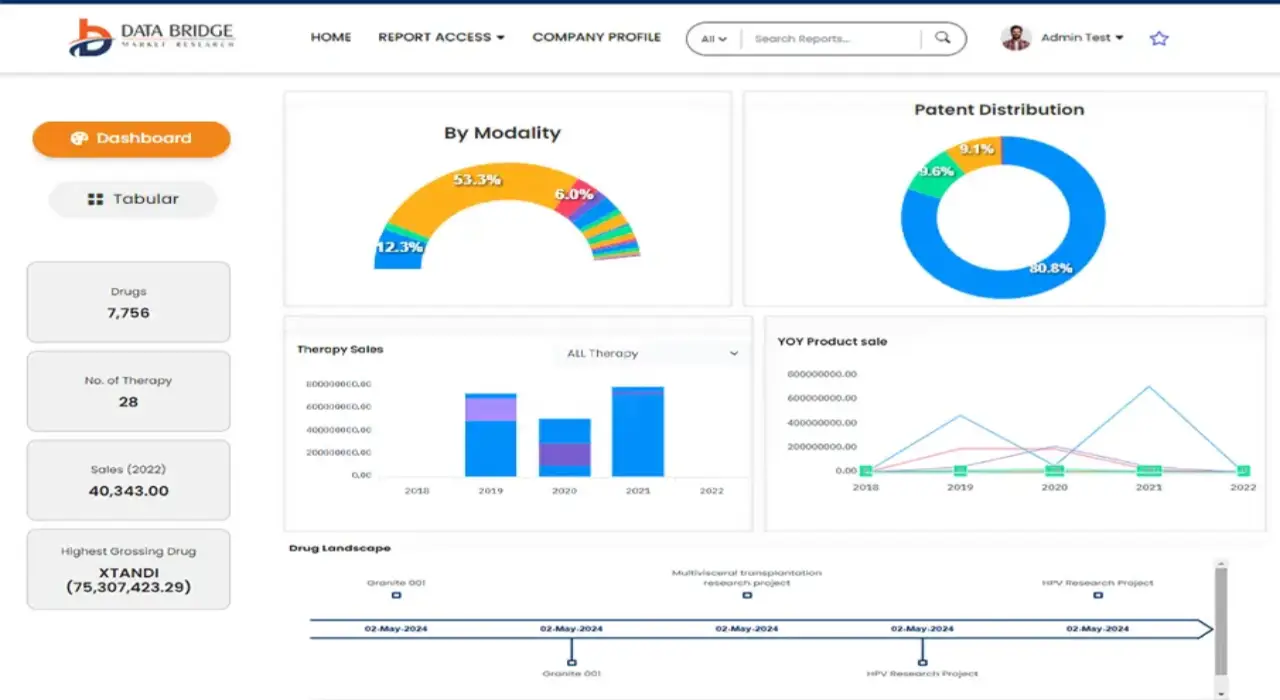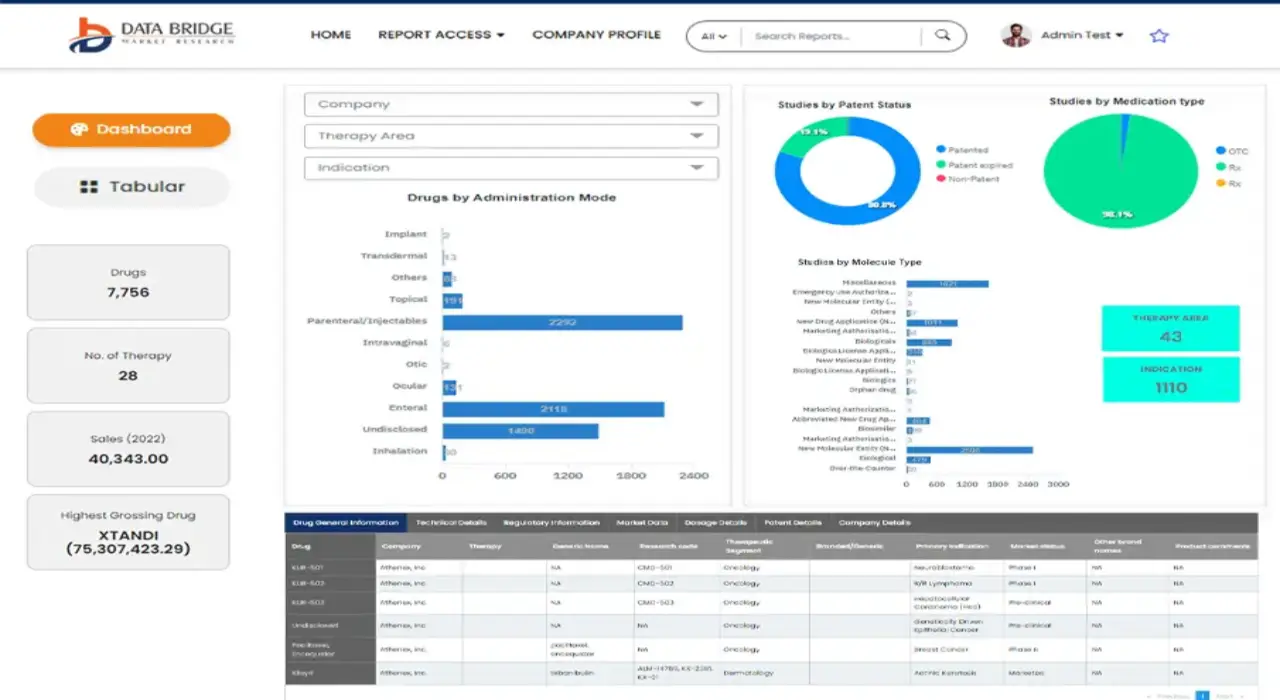Global Juvenile Polyposis Treatment Market
Market Size in USD Million
CAGR :
% 
 USD
585.20 Million
USD
832.21 Million
2024
2032
USD
585.20 Million
USD
832.21 Million
2024
2032
| 2025 –2032 | |
| USD 585.20 Million | |
| USD 832.21 Million | |
|
|
|
|
Global Juvenile Polyposis Treatment Market Segmentation, By Disease types (Juvenile Polyposis of Infancy, Juvenile Polyposis Generalized and Juvenile Polyposis Coli), Symptoms (Rectal Bleeding, Diarrhea, Anemia, Bowel Obstruction, Abdominal Pain, Chronic Weight Loss, and Visible Rectal Polyp), Treatment (Sirolimus, Polypectomy, Surgery, and Others), Diagnosis(Colonoscopy, Blood Test, and Genetic Testing) , End-Users (Clinics, Hospitals, Diagnostic centres, Surgical centres, and others) – Industry Trends and Forecast to 2032
Juvenile Polyposis Treatment Market Analysis
The juvenile polyposis treatment market is witnessing growth due to advancements in diagnostic techniques and therapeutic approaches. Genetic testing, a key development, enables early detection of mutations in genes such as BMPR1A and SMAD4, improving patient outcomes. High-resolution endoscopy, including capsule endoscopy and narrow-band imaging, enhances visualization of polyps, enabling precise removal through minimally invasive techniques.
Biologic therapies, particularly monoclonal antibodies, target specific pathways associated with polyp development, reducing recurrence rates. Advances in genomic editing tools, such as CRISPR-Cas9, show potential for personalized treatment strategies by correcting underlying genetic mutations.
The integration of artificial intelligence (AI) into endoscopic equipment has significantly improved diagnostic accuracy. AI-powered systems analyze endoscopic images in real-time, distinguishing polyps from normal tissues. Furthermore, advancements in telemedicine allow remote consultations, enhancing accessibility to specialized care.
These advancements drive the juvenile polyposis treatment market, addressing unmet medical needs, improving quality of life, and promoting market growth. Expansion is bolstered by increased awareness, favorable reimbursement policies, and ongoing research.
Juvenile Polyposis Treatment Market Size
The global juvenile polyposis treatment market size was valued at USD 585.20 million in 2024 and is projected to reach USD 832.21 million by 2032, with a CAGR of 4.50% during the forecast period of 2025 to 2032. In addition to the insights on market scenarios such as market value, growth rate, segmentation, geographical coverage, and major players, the market reports curated by the Data Bridge Market Research also include depth expert analysis, patient epidemiology, pipeline analysis, pricing analysis, and regulatory framework.
Juvenile Polyposis Treatment Market Trends
“Precision Medicine Advancing Juvenile Polyposis Treatment Market”
The adoption of precision medicine is a key trend driving growth in the juvenile polyposis treatment market. Precision medicine tailors treatments based on genetic, environmental, and lifestyle factors unique to each patient. Advanced genomic sequencing technologies enable early detection of hereditary polyposis syndromes, guiding targeted therapies. For instance, molecular diagnostics identify SMAD4 and BMPR1A gene mutations, which are linked to juvenile polyposis, leading to more effective, individualized management plans. This approach reduces complications, improves outcomes, and minimizes unnecessary interventions. The growing awareness and availability of such personalized treatments, supported by advancements in genomics and bioinformatics, are boosting the market’s growth trajectory.
Report Scope and Juvenile Polyposis Treatment Market Segmentation
|
Attributes |
Juvenile Polyposis Treatment Key Market Insights |
|
Segments Covered |
|
|
Countries Covered |
U.S., Canada and Mexico in North America, Germany, France, U.K., Netherlands, Switzerland, Belgium, Russia, Italy, Spain, Turkey, Rest of Europe in Europe, China, Japan, India, South Korea, Singapore, Malaysia, Australia, Thailand, Indonesia, Philippines, Rest of Asia-Pacific (APAC) in the Asia-Pacific (APAC), Saudi Arabia, U.A.E, South Africa, Egypt, Israel, Rest of Middle East and Africa (MEA) as a part of Middle East and Africa (MEA), Brazil, Argentina and Rest of South America as part of South America |
|
Key Market Players |
Pfizer Inc. (U.S.), CHEMWERTH INC. (U.S.), Albany Molecular Research Inc. (AMRI) (U.S.), Aurisco Pharmaceutical Co., Ltd. (South Korea), Biocon (India), Alkem Laboratories (India), Dr. Reddy’s Laboratories Ltd. (India), Concept Medical (India), Torrent Pharmaceuticals Ltd. (India), Zydus Cadila (India), Intas Pharmaceuticals Ltd. (India), and Concord Biotech (India) |
|
Market Opportunities |
|
|
Value Added Data Infosets |
In addition to the insights on market scenarios such as market value, growth rate, segmentation, geographical coverage, and major players, the market reports curated by the Data Bridge Market Research also include depth expert analysis, patient epidemiology, pipeline analysis, pricing analysis, and regulatory framework. |
Juvenile Polyposis Treatment Market Definition
Juvenile polyposis treatment focuses on managing and preventing complications such as gastrointestinal bleeding, anemia, or cancer. Treatment options depend on the number, size, and location of polyps and the patient's symptoms. Endoscopic polypectomy is commonly used to remove polyps, helping to reduce symptoms and prevent malignancy. For extensive polyps or high cancer risk, partial or total colectomy may be necessary. Regular surveillance with endoscopy or colonoscopy is crucial to monitor and manage recurrence. Genetic counseling and testing are recommended, as juvenile polyposis is often hereditary. Early detection and a multidisciplinary approach enhance outcomes and improve the quality of life for patients.
Juvenile Polyposis Treatment Market Dynamics
Drivers
- Rising Prevalence of Gastrointestinal Disorders
The increasing prevalence of gastrointestinal polyps among children significantly boosts the juvenile polyposis treatment market. These benign growths, if untreated, can lead to complications such as bleeding or bowel obstruction, prompting early diagnosis and treatment. For instance, the rise in cases reported by pediatric gastroenterology clinics has driven demand for advanced diagnostic tools such as genetic screening and imaging technologies. Treatments, including minimally invasive endoscopic procedures, are becoming more sought-after. A study published in a leading gastroenterology journal highlighted a 20% rise in juvenile polyposis cases over the past decade, emphasizing the need for improved therapeutic options. This trend encourages innovation and enhances market expansion.
- Focus on Minimally Invasive Therapies
The preference for minimally invasive procedures significantly boosts the juvenile polyposis treatment market. Advanced endoscopic techniques, such as polypectomy and endoscopic mucosal resection, allow precise removal of polyps with reduced recovery times, minimal discomfort, and lower risk compared to traditional surgeries. For instance, pediatric patients treated with capsule endoscopy experience improved diagnostic accuracy without the invasiveness of standard endoscopy. These advantages enhance patient and caregiver acceptance, making such therapies the preferred choice in clinical settings. Innovations such as robot-assisted endoscopic procedures further expand the scope of minimally invasive options, driving market demand as healthcare providers prioritize patient comfort and safety.
Opportunities
- Increased Investments in Pediatric Gastroenterology
Enhanced funding in pediatric gastroenterology has significantly improved diagnostic and treatment infrastructure for juvenile polyposis, driving market growth. For instance, initiatives such as the U.S. NIH funding programs have enabled advancements in pediatric endoscopic technologies and genetic research. Such investments have led to the establishment of specialized care centers equipped with advanced tools for early detection and minimally invasive treatment of juvenile polyps. In addition, collaborations between hospitals and biopharmaceutical firms have resulted in innovative therapies targeting pediatric gastrointestinal disorders. These efforts not only improve patient outcomes but also increase accessibility to state-of-the-art treatments, thereby expanding the juvenile polyposis treatment market globally.
- Technological Innovations in Endoscopic Procedures
Advancements in endoscopic techniques, particularly capsule endoscopy, are creating significant opportunities in the juvenile polyposis treatment market. Capsule endoscopy allows non-invasive visualization of the gastrointestinal tract, making early detection and monitoring of polyps more efficient. For instance, technologies such as PillCam, developed by Medtronic, provide patients with a safer and more comfortable alternative to traditional endoscopy. These minimally invasive methods reduce recovery times and procedural risks, enhancing patient preference for such treatments. In addition, integration with AI-based diagnostic tools further improves polyp identification and treatment planning. The growing adoption of these advanced endoscopic solutions is driving demand and fostering growth opportunities in the market.
Restraints/Challenges
- Lack of Effective Treatment Options
The lack of effective treatment options for juvenile polyposis significantly hinders market growth. While symptom management through surveillance and surgery is common, there are very few approved drugs that target the underlying genetic cause of the disorder. This limitation restricts the development of comprehensive treatment plans and reduces the appeal of the market to pharmaceutical companies. The absence of targeted therapies means that many patients rely on preventive measures and invasive procedures rather than curative treatments. Furthermore, the slow pace of innovation in this area limits patient access to more effective solutions, which in turn hampers the market's potential to expand and address unmet medical needs.
- High Treatment Costs
High treatment costs are a significant restraint in the juvenile polyposis (JP) treatment market. Genetic testing, specialized treatments, and long-term management of the condition require considerable financial investment, making access difficult, particularly in low-resource regions. The expenses involved in diagnostic procedures, surgeries, and continuous monitoring add to the financial burden on patients and healthcare systems. This is especially problematic for families without sufficient insurance coverage or in countries with limited healthcare funding. The high cost of treatment limits the number of patients who can afford proper care, restricting market growth and potentially leading to delayed or inadequate treatment for those affected by juvenile polyposis.
This market report provides details of new recent developments, trade regulations, import-export analysis, production analysis, value chain optimization, market share, impact of domestic and localized market players, analyses opportunities in terms of emerging revenue pockets, changes in market regulations, strategic market growth analysis, market size, category market growths, application niches and dominance, product approvals, product launches, geographic expansions, technological innovations in the market. To gain more info on the market contact Data Bridge Market Research for an Analyst Brief, our team will help you take an informed market decision to achieve market growth.
Juvenile Polyposis Treatment Market Scope
The market is segmented on the basis of disease types, symptoms, treatment, diagnosis, and end-users. The growth amongst these segments will help you analyze meagre growth segments in the industries and provide the users with a valuable market overview and market insights to help them make strategic decisions for identifying core market applications.
Disease types
- Juvenile Polyposis of Infancy
- Juvenile Polyposis Generalized
- Juvenile Polyposis Coli
Symptoms
- Rectal Bleeding
- Diarrhea
- Anemia
- Bowel Obstruction
- Abdominal Pain
- Chronic Weight Loss
- Visible Rectal Polyp
Treatment
- Sirolimus
- Polypectomy
- Surgery
- Others
Diagnosis
- Colonoscopy
- Blood Test
- Genetic Testing
End-Users
- Clinics
- Hospitals
- Diagnostic centres
- Surgical centres
- others
Juvenile Polyposis Treatment Market Regional Analysis
The market is analysed and market size insights and trends are provided by country, disease types, symptoms, treatment, diagnosis, and end-users as referenced above.
The countries covered in the market report are U.S., Canada, Mexico in North America, Germany, Sweden, Poland, Denmark, Italy, U.K., France, Spain, Netherland, Belgium, Switzerland, Turkey, Russia, Rest of Europe in Europe, Japan, China, India, South Korea, New Zealand, Vietnam, Australia, Singapore, Malaysia, Thailand, Indonesia, Philippines, Rest of Asia-Pacific (APAC) in Asia-Pacific (APAC), Brazil, Argentina, Rest of South America as a part of South America, U.A.E, Saudi Arabia, Oman, Qatar, Kuwait, South Africa, Rest of Middle East and Africa (MEA) as a part of Middle East and Africa (MEA)
North America is expected to dominate the juvenile polyposis treatment market due to the presence of major key players and a well-established healthcare sector. The region benefits from advanced medical infrastructure, ensuring the availability of cutting-edge treatments. In addition, increasing government support for research and development activities in healthcare, along with rising awareness and early diagnosis of juvenile polyposis, further strengthens the market's growth prospects in North America.
Asia Pacific is expected to show lucrative growth in the juvenile polyposis treatment market during the forecast period due to advancements in treatment technologies, increased research activities focusing on rare diseases, and growing healthcare expenditure. In addition, the rising awareness about juvenile polyposis, coupled with improved healthcare infrastructure, is expected to drive the demand for more effective therapies, ultimately contributing to the market's expansion in the region.
The country section of the report also provides individual market impacting factors and changes in regulation in the market domestically that impacts the current and future trends of the market. Data points such as down-stream and upstream value chain analysis, technical trends and porter's five forces analysis, case studies are some of the pointers used to forecast the market scenario for individual countries. Also, the presence and availability of global brands and their challenges faced due to large or scarce competition from local and domestic brands, impact of domestic tariffs and trade routes are considered while providing forecast analysis of the country data.
Juvenile Polyposis Treatment Market Share
The market competitive landscape provides details by competitor. Details included are company overview, company financials, revenue generated, market potential, investment in research and development, new market initiatives, global presence, production sites and facilities, production capacities, company strengths and weaknesses, product launch, product width and breadth, application dominance. The above data points provided are only related to the companies' focus related to market.
Juvenile Polyposis Treatment Market Leaders Operating in the Market Are:
- Pfizer Inc. (U.S.)
- CHEMWERTH INC. (U.S.)
- Albany Molecular Research Inc. (AMRI) (U.S.)
- Aurisco Pharmaceutical Co., Ltd. (South Korea)
- Biocon (India)
- Alkem Laboratories (India)
- Dr. Reddy’s Laboratories Ltd. (India)
- Concept Medical (India)
- Torrent Pharmaceuticals Ltd. (India)
- Zydus Cadila (India)
- Intas Pharmaceuticals Ltd. (India)
- Concord Biotech (India)
SKU-
Get online access to the report on the World's First Market Intelligence Cloud
- Interactive Data Analysis Dashboard
- Company Analysis Dashboard for high growth potential opportunities
- Research Analyst Access for customization & queries
- Competitor Analysis with Interactive dashboard
- Latest News, Updates & Trend analysis
- Harness the Power of Benchmark Analysis for Comprehensive Competitor Tracking
Research Methodology
Data collection and base year analysis are done using data collection modules with large sample sizes. The stage includes obtaining market information or related data through various sources and strategies. It includes examining and planning all the data acquired from the past in advance. It likewise envelops the examination of information inconsistencies seen across different information sources. The market data is analysed and estimated using market statistical and coherent models. Also, market share analysis and key trend analysis are the major success factors in the market report. To know more, please request an analyst call or drop down your inquiry.
The key research methodology used by DBMR research team is data triangulation which involves data mining, analysis of the impact of data variables on the market and primary (industry expert) validation. Data models include Vendor Positioning Grid, Market Time Line Analysis, Market Overview and Guide, Company Positioning Grid, Patent Analysis, Pricing Analysis, Company Market Share Analysis, Standards of Measurement, Global versus Regional and Vendor Share Analysis. To know more about the research methodology, drop in an inquiry to speak to our industry experts.
Customization Available
Data Bridge Market Research is a leader in advanced formative research. We take pride in servicing our existing and new customers with data and analysis that match and suits their goal. The report can be customized to include price trend analysis of target brands understanding the market for additional countries (ask for the list of countries), clinical trial results data, literature review, refurbished market and product base analysis. Market analysis of target competitors can be analyzed from technology-based analysis to market portfolio strategies. We can add as many competitors that you require data about in the format and data style you are looking for. Our team of analysts can also provide you data in crude raw excel files pivot tables (Fact book) or can assist you in creating presentations from the data sets available in the report.













